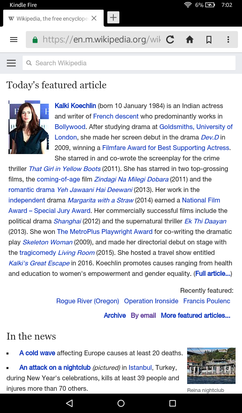

 | |
| Developer(s) | Amazon.com |
|---|---|
| Initial release | November 15, 2011; 12 years ago (2011-11-15) |
| Engine | Blink, V8 |
| Operating system | Fire OS |
| Available in | English, Spanish, French, Italian, Japanese, Chinese |
| Type | Mobile browser |
| License | Freeware, proprietary |
| Website | docs |
Amazon Silk is a web browser developed by Amazon. It was launched in November 2011 for Amazon Fire and Fire Phone,[1] and a Fire TV version was launched in November 2017.[2] The addition of Silk to the Echo Show was announced at an Amazon event in September 2018.[3]
The browser uses a split architecture where some of the processing is performed on Amazon's servers to improve webpage loading performance. It is based on the open source Chromium project that uses the Blink and V8 engines.
For each webpage, Silk decides which browser subsystems (networking, HTML or page rendering) to run locally on the device and which to run remotely on its own Amazon EC2 servers.
Silk uses Google's SPDY protocol to speed up loading of web pages.[4] Silk gives SPDY performance improvements for non-SPDY optimized websites if the pages are sent through Amazon's servers.[citation needed] Some early reviewers found that cloud-based acceleration did not necessarily improve page loading speed, most notably on faster connections or for simpler web pages.[5][6]
Some privacy organizations raised concerns with how Amazon passes Silk traffic via its servers, effectively operating as an Internet service provider for those using the browser. The Silk browser includes the option to turn off Amazon server-side processing.[7][8][9] On July 26, 2016 it was reported that Silk prevents access to Google over HTTPS, but that bug has since been fixed.[10]
Silk runs with the Amazon user account of the Amazon device running Silk. To access resources from another web account, external utility apps are available, e.g. to use Chrome bookmarks from a desktop or mobile web account.[11]
Amazon says "a thread of silk is an invisible yet incredibly strong connection between two different things", and thus calls the browser Amazon Silk as it is the connection between Kindle Fire and Amazon's EC2 servers.[12]
|
| |||||
|---|---|---|---|---|---|
| People |
| ||||
| Facilities |
| ||||
| Products and services |
| ||||
| Litigation |
| ||||
| Other |
| ||||
| Unions |
| ||||
|
| |||||||||||||||
|---|---|---|---|---|---|---|---|---|---|---|---|---|---|---|---|
| |||||||||||||||
| |||||||||||||||
| |||||||||||||||
| |||||||||||||||